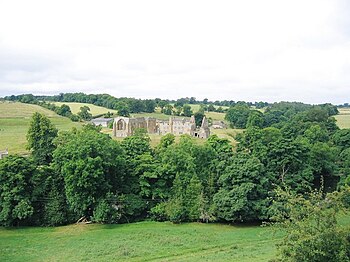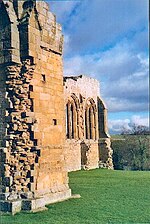Egglestone Abbey: Difference between revisions
Created page with "thumb|right|350px|View of Egglestone Abbey from the north, the [[River Tees is behind the line of trees]] File:Eggle..." |
No edit summary |
||
| Line 1: | Line 1: | ||
[[File:Egglestone Abbey - geograph.org.uk - 382192.jpg|thumb|right|350px|View of Egglestone Abbey from the north, the [[River Tees]] is behind the line of trees]] | [[File:Egglestone Abbey - geograph.org.uk - 382192.jpg|thumb|right|350px|View of Egglestone Abbey from the north, the [[River Tees]] is behind the line of trees]] | ||
[[File:Egglestone Abbey - geograph.org.uk - 125027.jpg|thumb|right|150px|Ruins of the Abbey]] | [[File:Egglestone Abbey - geograph.org.uk - 125027.jpg|thumb|right|150px|Ruins of the Abbey]] | ||
{{county|Yorkshire}} | {{county|Yorkshire}}{{riding|North}} | ||
{{riding|North}} | |||
'''Egglestone Abbey''' is an abandoned Premonstratensian Abbey in the [[North Riding of Yorkshire]], standing on the southern (Yorkshire) bank of the [[River Tees]], a mile and a half south-east of [[Barnard Castle]], which stands across the river in [[County Durham]]. | '''Egglestone Abbey''' is an abandoned Premonstratensian Abbey in the [[North Riding of Yorkshire]], standing on the southern (Yorkshire) bank of the [[River Tees]], a mile and a half south-east of [[Barnard Castle]], which stands across the river in [[County Durham]]. | ||
| Line 35: | Line 34: | ||
[[Category:Monastic sites in Yorkshire]] | [[Category:Monastic sites in Yorkshire]] | ||
[[Category:English Heritage sites in Yorkshire]] | [[Category:English Heritage sites in Yorkshire]] | ||
[[Category:Monastic sites in the North Riding of Yorkshire]] | |||
Revision as of 09:50, 25 September 2015


Egglestone Abbey is an abandoned Premonstratensian Abbey in the North Riding of Yorkshire, standing on the southern (Yorkshire) bank of the River Tees, a mile and a half south-east of Barnard Castle, which stands across the river in County Durham.
The site buildings are protected as a Scheduled Ancient Monument and they are maintained by English Heritage.
History
The Abbey was founded in the late 12th century at some point between 1168 and 1198. The founders were the Premonstratensians who wore a white habit and became known as the White Canons. The followed a code of austerity similar to that of Cistercian monks, unlike monks of other orders, they were exempt from the strict Episcopal discipline. They undertook preaching and pastoral work in the region (such as distributing meat and drink).
The Premonstratensians chose the site for the abbey because of its isolation, close proximity to a river and the supply of local stone for its construction.
In common with many of the early monasteries, the original church at Egglestone Abbey was enlarged, and partly rebuilt, about one hundred years later, it is this later church that survives today.
The abbey was always poor and at times had difficulty maintaining the required number of canons (twelve - from the twelve Apostles).
Egglestone Abbey was to suffer at the hands of Scottish invaders and the rowdy English army who were billeted there in 1346 on their way to the Battle of Neville's Cross.
The Abbey was dissolved in 1540 by King Henry VIII, the lands were granted to Robert Strelly in 1548, who converted some of the buildings into a great private house that was abandoned in the mid-19th century.
Eventually, much of the abbey was pulled down and some of the stonework was used to pave the stable yard at the nearby Rokeby Hall in the 19th century.
Other Premonstratensian Abbeys include;
- Shap Abbey in Westmorland and
- Easby Abbey in the North Riding of Yorkshire.
Outside links
| ("Wikimedia Commons" has material about Egglestone Abbey) |
- Location map: 54°31’52"N, 1°54’26"W
- Streetmap: NZ061151
- Egglestone Abbey – English Heritage
- National Monuments Record: No. 19827 – Egglestone Abbey
